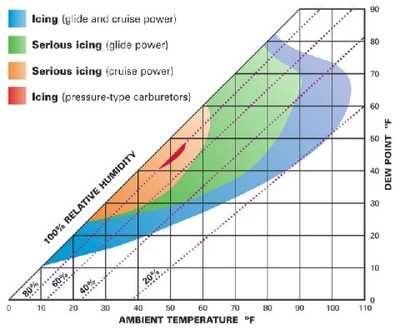Wed, Jul 01, 2009
Summer Means Higher Humidity, And A Chance For Ice
 The FAA has issued
a Special Airworthiness Information Bulletin designed to
inform pilots of the potential hazards associated with carburetor
icing. For now, this airworthiness concern is not considered an
unsafe condition that would warrant an AD, but is still a timely
reminder for summer flying.
The FAA has issued
a Special Airworthiness Information Bulletin designed to
inform pilots of the potential hazards associated with carburetor
icing. For now, this airworthiness concern is not considered an
unsafe condition that would warrant an AD, but is still a timely
reminder for summer flying.
The FAA says there were 212 accidents attributed to carburetor
icing between 1998 and 2007. Of these accidents,13 resulted in
fatalities. The certification requirements for carbureted airplanes
require that a heated source of air be provided as mitigation for
carburetor icing. The FAA and the Aircraft Owners and Pilots
Association (AOPA) have addressed the subject of carburetor icing
several times in various forms. Despite the certification
requirements, and the information provided by the FAA and AOPA, the
accident trend has remained fairly steady throughout the years.
Pilots should be aware that carburetor icing doesn’t just
occur in freezing conditions, it can occur at temperatures well
above freezing temperatures when there is visible moisture or high
humidity. Icing can occur in the carburetor at temperatures above
freezing because vaporization of fuel, combined with the expansion
of air as it flows through the carburetor, (Venturi Effect) causes
sudden cooling, sometimes by a significant amount within a fraction
of a second. Carburetor ice can be detected by a drop in rpm in
fixed pitch propeller airplanes and a drop in manifold pressure in
constant speed propeller airplanes. In both types, usually there
will be a roughness in engine operation. The graph below shows the
probability of carburetor icing for various temperature and
relative humidity conditions:

There are some steps a pilot can take to prevent, recognize, and
respond to carburetor icing. To prevent carburetor icing, the pilot
should:
- Assure the proper functionality of the carburetor heat during
the preflight check.
- Use carburetor heat on approach and descent when operating at
low power settings, or in conditions where carburetor icing is
probable.
To recognize carburetor icing, the warning signs are:
- A drop in rpm in fixed pitch propeller airplanes.
- A drop in manifold pressure in constant speed propeller
airplanes.
- In both types, usually there will be a roughness in engine
operation.
The pilot should respond to carburetor icing by applying full
carburetor heat immediately. The engine may run rough for short
time while ice melts. The FAA says these recommendations are
general suggestions. The pilot should consult the AFM or the
pilot's operating handbook for the proper use of carburetor
heat.
More News
Circle To Runway (Runway Number) Used by ATC to inform the pilot that he/she must circle to land because the runway in use is other than the runway aligned with the instrument appr>[...]
Aero Linx: National Aviation Safety Foundation (NASF) The National Aviation Safety Foundation is a support group whose objective is to enhance aviation safety through educational p>[...]
At Altitude Of About 250-300 Ft Agl, The Airplane Experienced A Total Loss Of Engine Power On November 6, 2024, at 1600 central standard time, a De Havilland DHC-1, N420TD, was inv>[...]
From 2009 (YouTube Edition): Three Hour Flight Was 'Flawless' -- At Least, Until Mother Nature Intervened For anyone who loves the aviation business, this was a VERY good day. Afte>[...]
Also: AMA Names Tyler Dobbs, More Falcon 9 Ops, Firefly Launch Unsuccessful, Autonomous F-16s The Air Force has begun ground testing a future uncrewed jet design in a milestone tow>[...]
 ANN's Daily Aero-Term (05.05.25): Circle To Runway (Runway Number)
ANN's Daily Aero-Term (05.05.25): Circle To Runway (Runway Number) ANN's Daily Aero-Linx (05.05.25)
ANN's Daily Aero-Linx (05.05.25) NTSB Prelim: De Havilland DHC-1
NTSB Prelim: De Havilland DHC-1 Classic Aero-TV: The Boeing Dreamliner -- Historic First Flight Coverage
Classic Aero-TV: The Boeing Dreamliner -- Historic First Flight Coverage Airborne-NextGen 05.06.25: AF Uncrewed Fighters, Drones v Planes, Joby Crew Test
Airborne-NextGen 05.06.25: AF Uncrewed Fighters, Drones v Planes, Joby Crew Test




